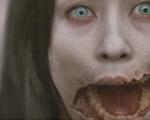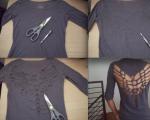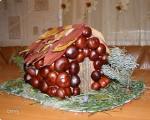A combination of two colors in eye makeup. Contrasting and related colors in eye makeup
The task of a makeup artist is to make the makeup flawless. This can be achieved by using a color wheel. A well-chosen palette is extremely important in the work of a makeup artist, as it makes it possible to:
- create an impeccable image;
- visually eliminate imperfections and emphasize the advantages of the face;
- refresh, rejuvenate the face;
- convey any mood: makeup can be positive, gentle, passionate, stunning, depressing, etc.
Types of flowers
The color wheel includes 12 main and mixed colors– this is the basis. Using it, a makeup artist can create additional shades: fuchsia, cherry, burgundy, mint, khaki, etc.
All the colors of the circle are divided into several groups.
Light and dark colors
For creating spectacular makeup The makeup artist should remember that light tones visually bring you closer and enlarge, while dark tones move away and make you smaller. Using this you can hide various disadvantages appearances such as:
- small or deep-set eyes: light pencils, eyeliners and shadows, including luminous or pearlescent ones, are suitable for this;
- drooping eyelids: dark matte shadows will help hide this deficiency;
- coarse facial features, excessively protruding facial elements: a blush darker than your skin tone is suitable;
- small lip volume: use light, pearlescent lipsticks or glosses;
- too big lips: dark will do Matt lipstick.
Warm and cool colors
 Warm tones bring you closer and larger, cold tones move away and make you smaller. Using this secret, you can correct external shortcomings:
Warm tones bring you closer and larger, cold tones move away and make you smaller. Using this secret, you can correct external shortcomings:
- To create volume on the cheekbones, blush in warm colors is optimal;
- for a thin and aristocratic face, use blush in cool tones;
- Lipsticks in warm colors will allow you to enlarge your lips;
- reduce lips – lipsticks in cool colors.
Achromatic and neutral colors
Achromatic, or neutral, are black, white and gray colors. These tones are universal: they go well with other shades of the circle.
Neutral colors enhance the contrast of adjacent colors, with white making them darker and black making them lighter.
The degree of saturation of any color is easy to influence: to mute or lighten you need to add white (this produces pastel and translucent tones), and to darken and add more saturation – black.
Contrasting colors
Colors located opposite each other are called contrasting, or opposite. These shades highlight each other and make the makeup brighter. Contrast in makeup is actively used to create flashy images during photo shoots.
Using contrasting colors allows you to achieve spectacular makeup and helps:
- emphasize the brightness and depth of the eyes, makes the look expressive: for example, for green eyes it is better to use purple shadows, for brown eyes golden beige, and fuchsia lipstick will highlight blue eyes;
- hide redness on the skin (acne, pimples, etc.): green corrector neutralizes redness;
- hide dark circles under the eyes: peach foundation will disguise blue or purple light;
- lighten the skin, give it radiance: a lilac base will help hide the yellowness of the skin.

Neighboring colors
Neighboring colors are 2-3 colors located nearby on the circle. The use of such tones allows you to create mono-makeup, or makeup in one color scheme.

Selecting a palette for make-up
When choosing a palette it is important individual approach. The color and brightness of the eyes, lips, hair, and skin tone should be taken into account. No less important is how much they contrast with each other. Also when selecting color range You should pay attention to the lady’s clothes and hairstyle: makeup should match the chosen image.
Professional makeup artists always take into account a woman’s color type when choosing a palette:
- Light type: blondes with bright eyes, eyebrows and eyelashes. Dark colors and contrasting combinations are not suitable for this type.
- Neutral type: pale skin, eyes and hair of muted colors, or tones of medium saturation. In makeup, preference should be given to soft, light colors with bright accents.
- Bright type: dark skin, dark hair and eyes. For such girls, both cold and warm colors. It is possible to use a mixed palette.
- Contrasting type: dark skin or dark eyes And blonde hair and vice versa. Accordingly, you need to select contrasting shades.
A makeup artist makes the image expressive, helps to hide external flaws and highlight advantages. This allows the girl to get rid of her complexes and gives her self-confidence. To some extent, a makeup artist is a magician. And it is impossible to create miracles without the magic of color. Using a color wheel will help a specialist reveal the beauty and charm of a lady.
The properties of colors to enhance and highlight each other are very often used in makeup. Especially large field for experimenting with color in eye makeup.
Exist different ways matching the color of shadows to the color of the eyes, but the most popular are the use of colors related to the color of the eyes and the use of colors that are complementary or split complementary to the color of the eyes. Today I will give examples of myself simple makeup using only one eyeshadow color.

Important Note : When using eyeshadow, make sure that the undertone color of the eyeshadow matches the undertone of your skin, otherwise you will get the effect of puffy eyes.
Eye shadow palettes from the book "Makeup in 5 Minutes" by Ray Morris









Interestingly, the border between transitional eye shades (all shades of green and gray) is very blurred , therefore green and grey eyes may change color slightly depending on makeup and clothing. For example, blue-green eyes may appear warm blue (color sea wave) or cool greens. Warm green eyes may appear light brown (hazel), etc. With the help of makeup, you can slightly change the color of chameleon eyes in one direction or another.
How it works
1) Complementary (opposite) colors
Complementary colors enhance each other, so next to a complementary color, the eye color will become brighter and more defined (i.e., more blue or greener or more brown)
Let's take a couple copper -aquamarine (blue-green)

Despite the photoshop, the principle of action is visible - the colors reinforce each other.
Let's try without Photoshop and vice versa - my eye color is dark grey-blue-green, moreover, skewed green

Let's try to emphasize the color with copper shadows and make the eyes bluer 
2) Related colors
Similar colors tend to adapt to each other, so in the vicinity of related colors the eye color may also seem brighter. However, makeup artists usually do not recommend using tone-on-tone eye shadows (you risk getting the appearance of a color spot that is unclear in outline) - it is better to use shadows slightly darker or lighter. Lighter shades will make your eyes appear darker; darker shades will make your eyes appear lighter.
Again, using related colors you can adjust the color a little:
The girl's eye color is probably gray-blue or gray-green, but when using turquoise eyeliner, her eyes appear turquoise.
Now let’s “test it for ourselves” again:
Light green: eye color appears very dark 
Dark green - it was very difficult to choose a darker shade - the eyes are enough rich color, however, I think the difference is noticeable compared to the previous picture - the eyes seem slightly lighter.
Have fun experimenting with color!
It turns out that this is possible. If you know a few simple rules makeup artists. By the way, they were borrowed from artists and colorists. And they have been used by representatives of these professions for hundreds of years, if not longer.
1. Explore color circle
Color wheel, or color wheel, is the basis for understanding the rules of color. Makeup theory additional colors- a real salvation, because harmony is created precisely thanks to additional colors. Complementary colors are pairs of colors that are opposite each other on the color wheel. For example, for purple additional is . And, conversely, for orange - purple. These colors complement each other, hence the name. For now, let’s remember this and try to put it into practice.

2. Shadows
The most big mistake– when women think that matching eye shadow to eye color means choosing the same shade of eye shadow as the eyes. This is the wrong decision. Two blue shades They don’t add brightness and clarity to each other in any way, but on the contrary, they make each other dull.
The right approach is to work on complementary colors. For example, for blue eyes blue shadows will not add expressiveness at all, but bronze, copper and even red shades will help highlight the pupil, making it a bright sapphire or turquoise.

For brown eyes, purple shadows are the most advantageous, for green eyes - brown, etc.

Note: an additional color can indicate not only what shade to choose, but also the nature of the color: cold or warm. If the complementary color to blue is red, then, in principle, any warm shade will be more advantageous than any cold one.

3. Blush
One of the main tips: – this is not a facial contouring product. That is, they do not “sculpt” the shape of the face, do not change it. Blush adds color to your face and brightens it up.
The second tip is right choice colors. Try to classify your skin as one of two types: 1) Ivory, beige; or 2) bronze. For the first type, light ones should be used, light shades, even a little cold. And for the second type, darker and warm colors. Look at the color wheel: warm shades are all those that are closer to red, and cool shades are closer to blue. Cool blushes are those in which blue (blue) is present, at least minimally.

In the summer, almost any skin becomes warmer (due to, even very light), so summer blush should be warmer than winter.
And the third rule - do not use blush darker than your own shade of natural blush. You should pinch the skin on your cheekbones or lightly tap it with your fingertips, and you will see how intense the blush can be.
Makeup artists refer to universal product, that is, the rules for selecting colors based on the “warm-cold” principle do not apply to it. Because bronzer is a shade tanned skin, it can be present on any skin tone. And the bronzer is suitable for both warm, olive and fair skin. The only question is the intensity of the bronzer color.
4. Lipstick
First, use the rule that dark colors they make the object visually smaller, while light ones, on the contrary, expand them. Here simplest example how it works: the circles are absolutely the same size, but the black one looks smaller, and the white one looks bigger.

Therefore, when thin lips It's better to choose a light lipstick rather than a dramatic plum one.
Another rule for choosing a lip color is to match your skin tone. The theory is the same as when choosing blush: for cool skin tones, you can choose cooler lipstick colors, and hot lipstick colors will suit darker complexions.

Take into account also. It's good if the lipstick is from the same group of colors as the shadows. That is, if the shadows are cold, then the lipstick is cold. If the shadows are warm, then choose a warm lipstick. Harmonious image often the most advantageous solution.
Professional make-up consists not only of using a variety of brushes and other cosmetic devices, but also of competently selecting, according to Itten’s color wheel, the individual color scheme of the model, emphasizing her beauty. In this article we will reveal the secrets harmonious combinations in makeup.
How to hide skin imperfections
Before applying decorative cosmetics, it is necessary to even out the skin tone and disguise its defects using special means. Thanks to contrasting colors neutralize each other, and when mixed, a neutral is obtained flesh tone. Since the red color in the Itten circle is opposed to green, it neutralizes redness, pimples and vascular network A green concealer mixed with the main tone will help on the skin.

To lighten up a little dark spots and give a bright shine yellowish skin face, apply a lilac-violet base on it, and highlight the cheekbones with a highlighter. When you need to remove darkening, redness and swelling under the eyes (both on the bottom and on the upper eyelid), apply yellow or peach concealer.

Bruises are a little more difficult because they all come in different shades:
Red, brown or purple are removed with a yellow corrector;
blue-gray - peach and orange.
The correct selection of blush according to Itten's color wheel makes the skin fresh and radiant. After masking skin defects, you need to even out your complexion tone and get rid of greasy shine. If you use only one foundation, it will make your complexion unnatural, so you can’t do without blush. They will help highlight the cheekbones and oval of the face and add volume. Blush is made with cream or powder texture in exclusively warm shades:
pink,
cherry,
plum,
beige,
peach
You also need to choose blush according to color rules.
Cannot be used more dark shade than a natural blush. To see its saturation, you need to lightly pinch the skin on your cheekbones.
Warm, luminous peach or beige blush is suitable for thin red- and blonde-haired women. light skin cold shade and blue eyes. Brown-eyed dark-skinned women with round face- cold plum and cherry with a slight addition of blue.
Because in the summer due to light tan the skin becomes darker, then summer blush should be a darker shade than winter blush.
Apply blush on top foundation before applying powder with a brush or sponge to the cheeks, tip of the nose and chin.

How to choose eye makeup using Itten's color wheel
It has long been out of fashion to use eye shadow and eyeliner to match the color of your iris. Many makeup artists believe that this does not fully emphasize the beauty and clarity of the look, making it dull.
Dark purple shadows add chic expressiveness to green eyes.
This makeup option is ideal for creating a custom look for a professional photo shoot.

For green-eyed people, dark burgundy, lilac and purple shadows that contain red pigment suit them. Pink eyeshadow, eyeliner and pink eyeliner should be avoided as they will give a tear-stained and puffy look. It is easiest to choose a complimentary eyeshadow tone for black-brown eyes, since the opposite color of black is white. The lighter the shadows, the stronger the contrast.

Blue or green eyeliner and mascara, but products decorative cosmetics These colors can increase the redness of the eyes.
To emphasize the brightness and richness of light blue eyes, use coral or peach shadows.

For cool skin tones, beige-brown shadows are suitable - both glossy and matte textures.
Any shade of shadow will suit owners of gray eyes. With their help, you can visually change the shade of the iris.
Do you dream of green eyes? Use eyeshadow with red pigment.
To achieve an emerald tint to the pupils, apply light lilac eyeshadow.
You can darken gray eyes with dark shadows with blue pigment.
Do you want your pupils to become sky blue? Give preference to neutral, nude shades of eyeshadow - beige or brown, as well as the classic triad - orange, purple and green. These techniques are often used Hollywood makeup artists and stylists when actors cannot wear colored lenses. Also in trend are copper, red and bronze shadows, which give the pupils a bright turquoise shade and shine.

If you use exclusively cold tones in your makeup, your facial features will look as if they were artificial. To make your look warmer and more cheerful, it is recommended to apply golden shadows to the inner corners of your eyes.
To the owners of eyes walnut color Do not overuse warm shades, otherwise the look will seem too heavy and annoying. You can highlight the lower eyelid thin line green or blue pencil.

What you need to know about choosing the right lipstick?
Main selection criteria decorative means for lips:
lip shape - dark colors (especially matte) visually make the lips smaller, and light satin glosses give them additional volume;
skin tone - more preferable for cool skin tones light lipsticks and shine, and when warm (dark and dark skin) - bright and dark;
hair color - lipstick should be one tone lighter than hair;
eye makeup - it is desirable that the lipstick color belongs to the same group as the eye shadow. If they warm shade, then the lipstick should be warm.
Sequins and mother-of-pearl are no longer in trend, and they don’t suit everyone.
Girls with fair and brown hair For fair skin and green eyes, coral, salmon and beige lipsticks are suitable in combination with brown, peach, bronze and golden shades.
Black- and brown-eyed women with fair skin suit raspberry, plum and bright pink tones of lip glosses and lipsticks.
For fair-skinned blondes, it is better to focus on the eyes using contrasting combination colors of the classic triad (blue, yellow, orange), and you will have to give up bright lipstick. In this case, gentle ones are preferable. matte shades- terracotta or apricot, for evening make-up - transparent pink. Stylists advise red-haired girls to use translucent lipsticks neutral colors- beige, caramel, light pink.
Brown-haired women should avoid cold shades of pink in lip makeup, and opt for red, brown and wine-colored lipsticks. Light-skinned brunettes look great with carrot, burgundy and red shades.

Experiment with colors. Using Itten's circle, create new original combinations and harmonious make-up according to your preferred range and style of clothing - and you will always look irresistible!
Have you ever wondered how these girls on the Internet do amazing eye makeup that only evokes admiration and (white) envy? We were. Yes, yes, many of them professional makeup artists. And others simply understand well which colors of shadows are best combined with each other. Believe me, you can do the same. And we suggest starting your path to the status of a beauty guru with these universal color combinations that will suit almost any eye and skin tone.
Do you want to learn how to do beautiful makeups but don't know where to start? Start with an eyeshadow palette, a good blending brush, and these color combinations. Just two shades, but they complement each other perfectly. And they will suit almost everyone.
1.Brown and gold
Timeless classic. These two shades can be found in almost any eyeshadow palette. And they will magically make any look warm. Even if you are the whitest “cold” blonde. Complete this color combo with a classic black pencil and don't forget to carefully blend the transition between the shadows.
2.Copper and deep blue
Despite its color versatility, the combination is for the brave. You definitely won't be left without attention. For this combination, makeup artists recommend using only matte shades, without glitter. And it would be suitable as an electric blue accent liquid eyeliner and/or long-lasting eyeliner. Finding them in such a bright color will not be difficult even among very, very budget cosmetics.
3.Cream “nude” and now fashionable “taupe”
Another example is very universal combination. Makeup from the line “both for the feast and for the world.” And all because the shades were selected as neutral as possible, not bright, but at the same time attracting attention to your eyes. Cream shadows or even liquid concealer are ideal as the main “flesh” color. And the shade “taupe” (gray-brown, depending on the lighting) is so fashionable now that it seems that everyone has released it cosmetic brands. So it’s easy to buy inexpensive “one-off” shadows and save a lot.
4.Rose and champagne
A very feminine and spring-summer combination. Pink shadows are a real hit and a must-have for all fashionable cosmetic bags this season. And the combination with the classic shade “champagne” makes the makeup not extreme, but soft and feminine. Especially if you use shadows with a soft shine, satin effect. Just what you need for a date or a romantic dinner.
5.Neon blue and mint green
That's for sure, not everyone will decide! But in vain. Despite the brightness, this combination will suit almost everyone. Of course, in winter makeup these “tropical” colors are unlikely to be appropriate, but at a summer resort - why not?



